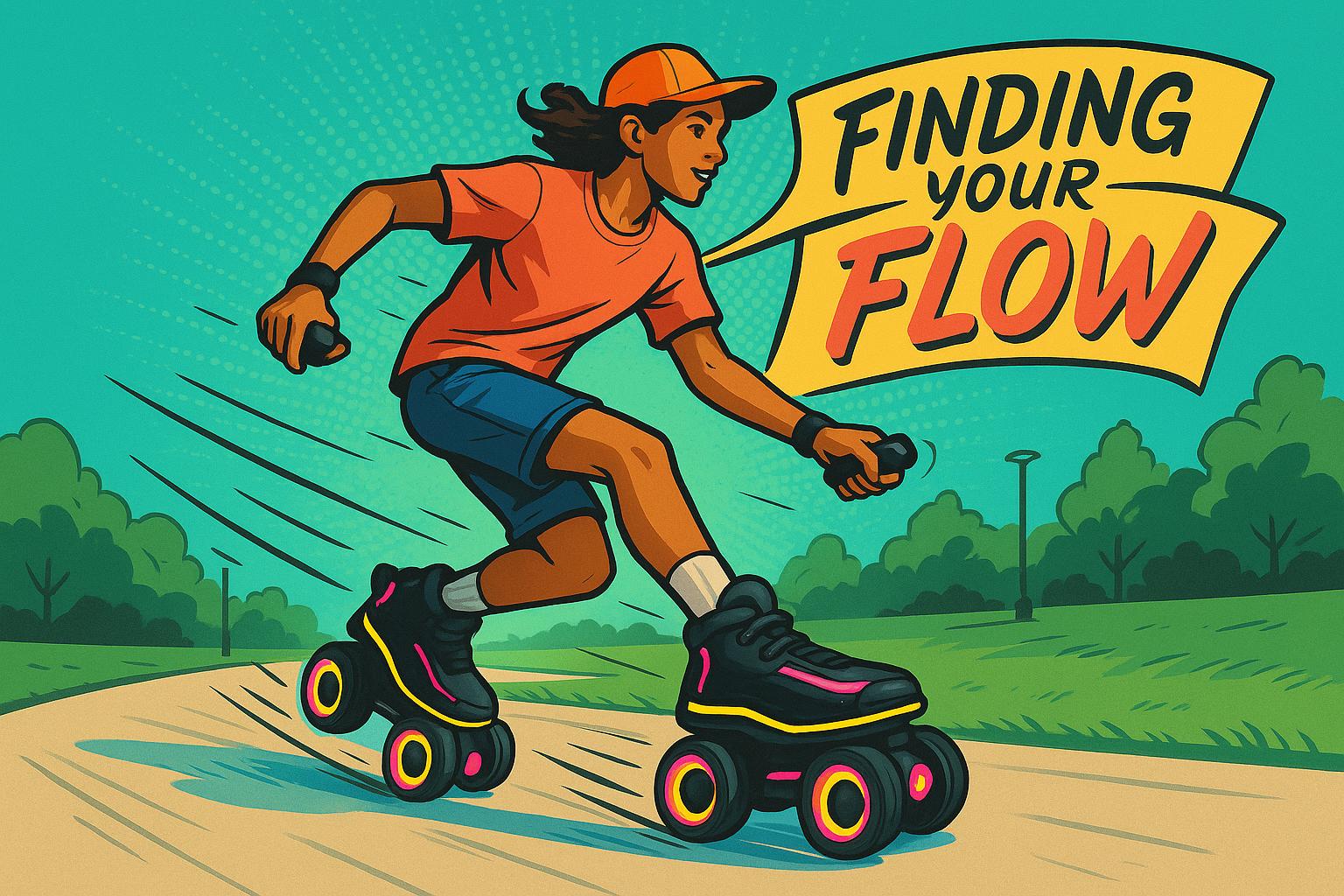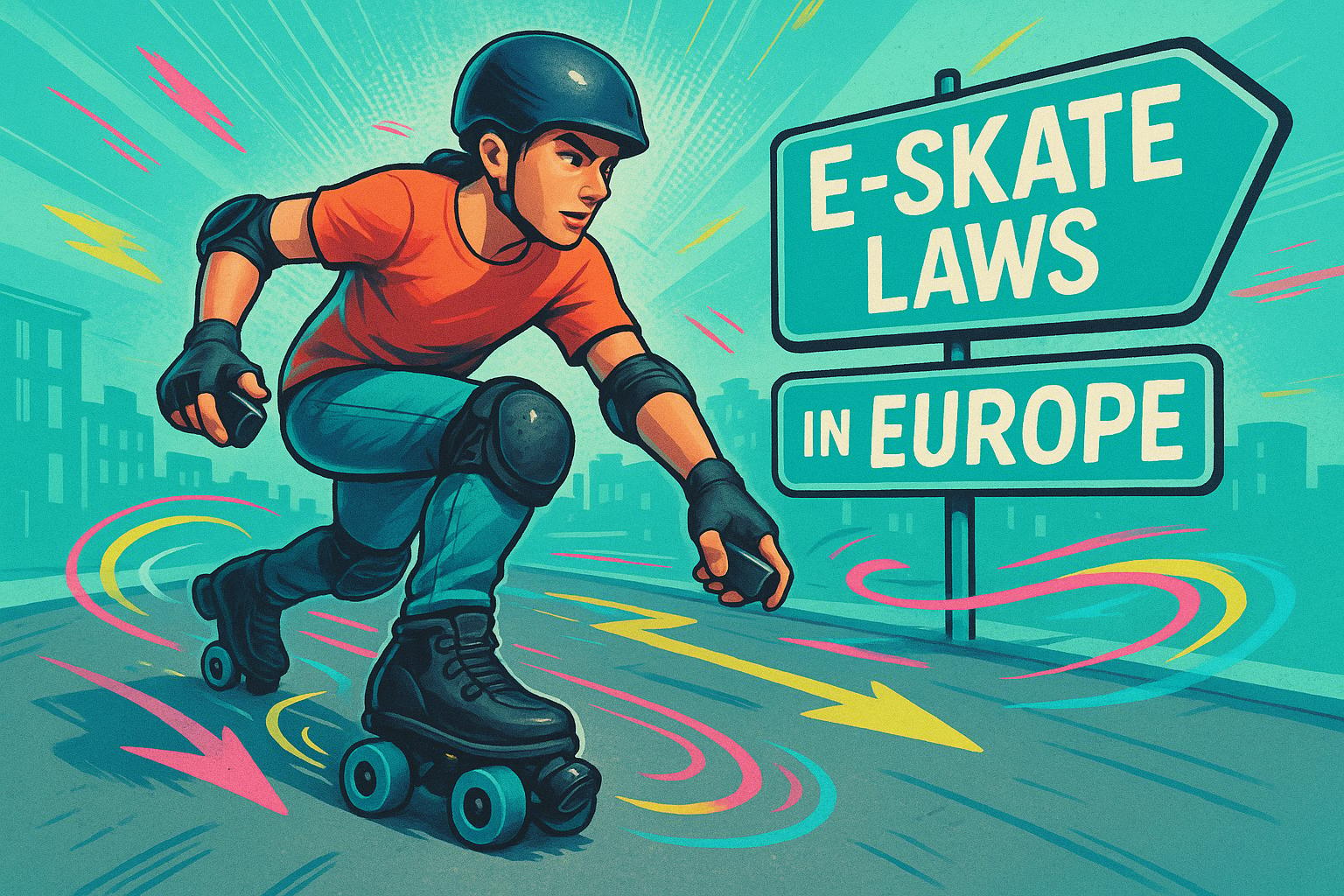Electric roller skates combine fun with practicality, offering a motorized way to glide through urban areas. Powered by brushless DC (BLDC) motors and lithium polymer batteries, these skates provide smooth rides, efficient energy use, and features like wireless controls and regenerative braking. They’re lightweight, easy to carry, and designed for short commutes, making them a smart choice for navigating busy cities. With speeds up to 15 mph and a range of 9 miles, they balance performance and safety.
Key Highlights:
- Motors: Brushless DC (BLDC) for quieter, efficient operation.
- Batteries: Lightweight lithium polymer with smart charging and regenerative braking.
- Controls: Wireless remotes for speed, braking, and customization.
- Performance: 15 mph max speed, 9-mile range, and dual-mode operation (electric/manual).
These features make electric roller skates a practical and eco-friendly option for short-distance travel.
These Inline Skates Have a MOTOR INSIDE !
Motor Components and Engineering
Electric skate motors combine precision craftsmanship with robust design to deliver efficient and lightweight performance. Let's take a closer look at how Brushless DC (BLDC) motors power these skates.
Brushless DC (BLDC) Motors Explained
BLDC motors are the go-to choice for electric skateboards, thanks to their efficiency and reliability. These motors often feature a 12N/14P configuration - 12 magnets and 14 poles - where the magnets are secured with epoxy and arranged in a convex pattern. Unlike traditional brushed motors that rely on physical contacts, BLDC motors use electronic switching to control their magnetic fields. This design not only boosts efficiency but also ensures a longer lifespan and quieter operation.
High-quality BLDC motors are built with components like NMB bearings, reinforced lock shafts, heat-resistant silicon cables, and multi-strand windings to handle heat and maintain performance. Some models even generate up to 4,200W of power.
A satisfied customer shared, "Models from 5065 to 63100 provide an ideal torque-to-weight balance and silent operation".
Battery Systems and Power Management
Battery systems play a key role in determining both range and performance by pairing advanced power management with BLDC motors. Let’s dive into the types of batteries that power these systems and how they work.
Battery Types and Capacities
Lithium polymer (LiPo) batteries are a popular choice due to their lightweight design and high power output. These batteries strike a balance between compactness and efficiency, making them ideal for modern electric vehicles. The voltage and capacity of the battery directly affect how far you can ride on a single charge. Some designs integrate the battery into the vehicle's frame for a sleek look, while others use removable packs for convenience. Regardless of the design, all systems include a Battery Management System (BMS) to prevent issues like overcharging, short circuits, or overheating.
Charging and Regenerative Braking
Smart chargers are designed to protect battery health by reducing the current as the battery nears full capacity, which helps prolong its lifespan. Another clever feature is regenerative braking. When you brake or ride downhill, the motors temporarily reverse their function, capturing kinetic energy and converting it back into stored power for the battery. This process boosts efficiency by recycling energy that would otherwise be wasted. Advanced systems even fine-tune the intensity of regenerative braking based on factors like battery charge level and riding conditions.
Tips for Extending Battery Life
Several factors influence how long a battery lasts, including rider weight, terrain, speed, and temperature. For instance, heavier loads, steep hills, or frequent rapid acceleration can drain the battery faster. Extreme temperatures - whether too hot or too cold - can also reduce capacity or activate safety measures that limit performance. To make your battery last longer, try to maintain steady speeds, avoid letting the battery drain completely, and aim to keep the charge level within an optimal range. Small habits like these can go a long way in preserving battery health.
Control Systems and User Interface
While motor components provide the raw power, it’s the control systems and sensors that transform it into a smooth, responsive ride. These systems translate user input into precise motor actions, creating an intuitive experience that feels natural and effortless.
Wireless Remote Control Technology
Wireless remote controls act as the bridge between the rider and the skate, using radio frequency signals to transmit commands almost instantly. A handheld transmitter communicates with a receiver inside the skate's base, which then activates the motor and steering systems to adjust speed and direction.
The remotes are designed for simplicity: a thumb-operated throttle manages acceleration, deceleration, and braking with ease. Pressing the throttle increases speed, while releasing it engages freewheel mode, giving riders the sensation of traditional skating. Additional features include a Backwards Mode and battery indicators for both the remote and the skate's power pack.
Modern remotes go beyond basic functions, handling throttle, braking, and reverse operations seamlessly. Many now include Bluetooth-enabled apps, offering a suite of customization options. Riders can tweak acceleration curves, adjust brake sensitivity, monitor battery levels, and even control LED lighting through these apps. This combination of physical controls and app-based customization ensures a tailored experience for every rider.
Speed Settings and Dual Modes
Electric skates today come with adjustable speed settings to suit different skill levels and riding conditions. These settings allow riders to fine-tune acceleration, braking, and overall power delivery, making the ride as gentle or as dynamic as they prefer.
One standout feature is the inclusion of dual modes. For instance, when the throttle is released, many systems automatically switch to freewheel mode. This lets the wheels spin freely without motor resistance, conserving battery power and offering a traditional skating experience.
Speed settings also play a key role in safety. Beginner modes offer softer acceleration and more gradual braking, helping new riders build confidence. In contrast, advanced modes deliver a more powerful and responsive performance, catering to experienced users looking for a thrill.
Onboard Sensors for Precise Control
Onboard sensors take responsiveness to the next level by fine-tuning motor output in real time. These sensors ensure smooth acceleration and braking by precisely managing torque and power delivery.
Beyond improving control, these systems optimize energy use, helping to extend battery life. For example, during braking, sensors detect the rotor's position with precision, enabling accurate regenerative braking.
Advanced sensor arrays, including Inertial Measurement Units (IMUs), wheel speed sensors, and strain gauges, process multiple inputs simultaneously. This ensures stability across various speeds and terrains. In some systems, sensors even enable hands-free control by detecting shifts in body weight and position, allowing riders to steer, accelerate, and brake intuitively.
Paired with AI algorithms, smart sensors can adjust torque and power output automatically based on terrain, making uphill climbs and downhill descents effortless. These systems also monitor the board's performance, providing alerts for maintenance or potential issues. For added safety, sensors can detect hazards like speed bumps or holes, adjust the board's height, and prevent oversteering. They also enhance stability, especially for heavier riders.
sbb-itb-bf837b9
Performance, Speed, and Durability
Motor technology is at the heart of how well electric skates perform and endure the challenges of daily urban commuting. The way these components are designed and tuned can make or break your riding experience.
Key Motor Specifications
When it comes to performance, BLDC motors are the standard, and their specs play a huge role in how your skates handle. Here's what matters:
- Wattage: This measures the motor's power. A higher wattage means stronger acceleration and better performance on inclines. Of course, factors like the motor's design, the rider's weight, and the terrain also come into play.
- Torque: This is the motor's rotational force. More torque means faster acceleration and the ability to climb hills with ease, which is crucial for stop-and-go city riding or steep terrain.
- Gear Ratio: The relationship between the motor and wheel gearing affects speed and acceleration. A setup designed for top speed might compromise on quick starts, while one focused on torque ensures better responsiveness for inclines and starts.
- Efficiency: This tells you how well the motor converts battery power into movement. A more efficient motor not only extends your range but also reduces how often you need to charge, making it a key factor for everyday use.
These specs aren't just numbers - they directly shape how your skates perform in real-world conditions.
Real-World Performance Insights
In urban settings, electric skates are designed to balance performance with practicality. For instance, maintaining a steady speed on flat ground helps conserve battery life, while frequent starts, stops, or riding uphill will use more energy. Even the weather plays a role - cold temperatures can impact battery efficiency, reducing your range.
Speed is another factor tailored for city life. Electric skates are engineered to move fast enough to keep up with bike paths and urban traffic, but not so fast that safety becomes a concern. This balance ensures a smooth and reliable commuting experience.
Striking a Balance Between Power and Durability
Performance is only half the story - durability is just as important, especially for regular riders. Motors vary in design:
- Entry-Level Motors: Great for casual rides but not built for heavy use.
- Mid-Range Motors: Offer a balance of power, range, and weight, making them ideal for daily commuters.
- Performance Motors: Deliver maximum power but require larger batteries and reinforced builds to handle the strain.
Durability also depends on the quality of components like motor bearings, heat dissipation systems, and weatherproofing. Motors with effective heat management and sturdy designs are less likely to fail over time, ensuring you get consistent performance for years to come.
Motor Technologies in Wheelfeet Skates

What Makes Wheelfeet Motors Different
Wheelfeet motors pack a punch with their efficient power delivery, smart energy usage, and solid durability, letting riders cruise through urban streets at speeds of up to 15 mph. The regenerative braking system adds another layer of practicality by converting kinetic energy into battery power, ensuring smoother stops and longer rides.
Each skate is designed with weight in mind, tipping the scales at just 4.8 lbs (2.2 kg). This lightweight build not only reduces strain but also lowers the center of gravity, making the ride more stable and secure.
The motor itself is cleverly integrated into the skate frame. This design shields it from bumps and bad weather while maintaining the smooth, natural feel of traditional roller skating. These thoughtful features make a noticeable difference for riders, combining performance with convenience.
User Benefits and Examples
Thanks to these advancements, riders enjoy a more controlled and hassle-free experience. The skates offer responsive acceleration, intuitive wireless controls, and the flexibility of dual-mode operation, allowing for safe deceleration and easy switching between electric and manual skating.
Wheelfeet Key Features Summary
| Feature | Specification | User Benefit |
|---|---|---|
| Motor Power | Up to 15 mph (25 km/h) | Quick urban travel, ideal for bike lanes |
| Weight | 4.8 lbs (2.2 kg) per skate | Lightweight for less fatigue and portability |
| Range | Up to 9 miles (15 km) per charge | Full-day commuting without recharging |
| Braking System | Regenerative energy capture | Longer battery life and smoother, safer stops |
| Frame Material | Lightweight aluminum | Durable yet easy to handle |
| Control System | Wireless remote with speed settings | Customizable and hands-free operation |
| Compatibility | Fits US shoe sizes 6–13 | Suitable for most adult users |
| Dual Mode | Electric and manual operation | Flexibility for various riding conditions |
With these motor technologies, Wheelfeet skates deliver a powerful, efficient electric skating experience that’s perfect for urban commuters. The focus on regenerative braking, lightweight design, and integrated construction sets them apart, offering both performance and practicality for everyday riders.
Conclusion
Electric skate motors combine precise engineering with practical functionality. From brushless DC motors that offer smooth and efficient power delivery to regenerative braking systems that help extend battery life, every feature is designed to enhance the riding experience.
These technical advancements highlight why electric skates are so effective for urban commuting. The combination of lightweight, durable construction with wireless control systems and dual-mode functionality brings clear advantages in performance and usability.
Take Wheelfeet's motor design, for instance. With a top speed of 15 mph and a range of 9 miles, it demonstrates how performance and portability can go hand in hand. Features like regenerative braking not only save energy but also pave the way for more environmentally friendly transportation solutions.
As motor technology advances, electric roller skates are set to play an even bigger role in urban mobility. With dependable brushless motors, smart battery systems, and responsive controls, they offer a practical and enjoyable option for daily use.
Whether you're zipping to work or cruising around your neighborhood, modern electric skate motors provide the power, control, and efficiency needed for a smooth ride. This progress in motor technology makes electric skates a smart and eco-conscious choice for navigating today’s urban landscapes.
FAQs
How do brushless DC (BLDC) motors enhance the performance and durability of electric skates?
Brushless DC (BLDC) motors have transformed the performance of electric skates, delivering better efficiency, less wear, and improved reliability compared to traditional motor designs. Unlike their brushed counterparts, BLDC motors do away with physical brushes, reducing the number of components that can wear out. This results in less maintenance and a lifespan that can stretch into tens of thousands of hours - all while maintaining steady performance.
These motors are also impressively efficient, with some models reaching up to 95% energy efficiency. What does this mean for riders? Smoother rides, higher speeds, and extended battery life. On top of that, BLDC motors generate less heat and produce minimal electrical noise, enhancing their durability and ensuring a quieter, more comfortable ride. With their combination of performance and longevity, BLDC motors are the go-to choice for powering electric skates, offering riders an unmatched experience.
How does regenerative braking work in electric skates, and what are its benefits for battery life and efficiency?
Regenerative braking in electric skates takes the energy typically wasted during braking and turns it into electricity, which is stored in the battery. This clever system not only helps increase the skate's range but also makes the energy use more efficient overall.
Beyond extending battery life, regenerative braking eases the wear and tear on traditional braking parts like pads and rotors. This means fewer maintenance expenses in the long run. It's a smart feature that boosts performance while also being kinder to the environment, giving you a smoother and more sustainable ride.
What are the best ways to extend the battery life of electric skates, and what factors can impact their performance the most?
To get the most out of your electric skates' battery, avoid letting it completely drain or overcharge. Instead, try to keep the charge level between 20% and 90%. If you're planning to store the skates for an extended period, aim to leave the battery at about 50% charge. Also, be mindful of temperature extremes - both heat and cold can take a toll on the battery's longevity. Rapid charging might seem convenient, but doing it too often can wear the battery down faster over time.
Several factors can influence battery performance, including extreme temperatures, deep discharges, and high charging or discharging rates. By paying attention to these aspects, you’ll not only improve your skates' performance but also extend their lifespan, ensuring more dependable rides and longer use.




Leave a comment
All comments are moderated before being published.
This site is protected by hCaptcha and the hCaptcha Privacy Policy and Terms of Service apply.